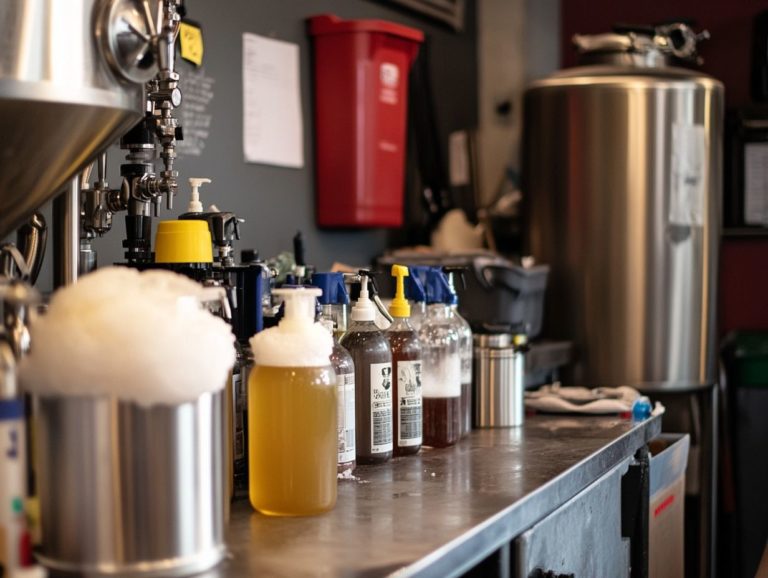5 Ways to Troubleshoot Your Brewing Process
Brewing at home can be an incredibly rewarding hobby, yet it comes with its fair share of challenges. Whether you’re a seasoned brewer or just dipping your toes into the craft, grasping the common pitfalls can truly transform your journey toward crafting that perfect pint of high-quality beer.
This article presents five essential troubleshooting tips designed to refine your brewing process. You’ll learn everything from scrutinizing your brewing equipment and ingredients to closely monitoring fermentation and seeking guidance from seasoned brewers. With these insights, you’re equipped to elevate your brewing game to new heights.
Embark on this journey to brewing success and unlock the full potential of your brewing craft!
Contents
- Tips for Successful Brewing
- 3. Monitor Your Fermentation Process
- 4. Consider Water Quality and Temperature
- 5. Seek Advice from Experienced Brewers
- What Are the Most Common Brewing Mistakes?
- Learning from Experience
- How Can You Determine the Cause of a Brewing or Fermentation Problem?
- What Are the Key Factors to a Successful Brewing Process?
- How Can a Homebrewer Improve Their Brewing Techniques and Skills?
- What Are Some Common Brewing Myths and Misconceptions?
- How Can a Homebrewer Troubleshoot Their Equipment Effectively?
- Frequently Asked Questions
Key Takeaways:

- Ensure your equipment is clean, calibrated, and functioning properly.
- Review your brewing recipe and ingredients for potential issues, such as expired ingredients or incorrect measurements, which can affect your brewing quality.
- Monitor your fermentation process, including temperature and yeast activity, to ensure proper fermentation and avoid off-flavors.
1. Check Your Equipment
In the realm of beer brewing, you cannot underestimate the significance of checking your brewing equipment. The efficiency of your brewing process hinges on the condition and cleanliness of your tools.
Keeping your brewing equipment in peak condition is vital for crafting high-quality beer; after all, neglected or poorly maintained equipment can lead to a host of issues, from inconsistent temperatures to carbonation problems.
Regular brewing inspections are essential to circumvent brewing challenges and ensure your brewing batch meets the highest brewing standards. Each type of brewing tool like fermenters (the containers where yeast converts sugars into alcohol), kettles (the pots used for boiling), and chilling units (the devices that cool your brew) holds a crucial role in the brewing process.
By cleaning your brewing equipment regularly, you can prevent the build-up of unwanted bacteria and residues that could compromise the flavor and quality of your brew. To extend the life of your equipment, it s wise to establish a brewing maintenance schedule that includes thorough inspections for wear, tear, and leaks.
Utilizing specialized cleaning solutions and adhering to manufacturer guidelines will ensure that each piece maintains its optimal performance, setting the stage for a clean and successful brewing experience.
2. Review Your Recipe and Ingredients
A critical aspect of achieving your brewing success lies in meticulously reviewing your brewing recipes and ingredients, as each component directly influences the final product’s flavor and quality.
Selecting the right malt and hops is essential for enhancing malt efficiency and contributing to your desired flavor profile. Keep in mind that variations in brewing ingredients can lead to significant differences in the brewing process.
Understanding the impact of your ingredient choices on brewing quality enables you to refine your brewing methods and create more consistent batches. Different types of malts such as pale, caramel, and roasted offer a range of flavor notes, from sweetness to bitterness, each complementing distinct styles of beer.
Hops, on the other hand, are not just for bitterness; they also impart aromatic qualities that can elevate your brew to new heights. By recognizing how these elements interact, adjust your recipes with confidence based on your past brewing adventures!
This iterative process not only enhances the overall quality but also fosters your creativity, ultimately leading to exceptional brews that are sure to impress both enthusiasts and casual drinkers alike.
Now that you’re equipped with these tips, start brewing today and share your experiences with fellow enthusiasts!
Tips for Successful Brewing
3. Monitor Your Fermentation Process
Monitoring your fermentation process is essential to your brewing journey, whether it’s a brewing hobby or a brewing career. It directly influences yeast performance and shapes the quality and flavor of your beer.
By managing your fermentation tank effectively, you can control the fermentation duration and identify issues before they escalate. Paying close attention to brewing measurements and keeping optimal conditions will help you achieve your desired original gravity and carbonation levels.
Several factors play a crucial role during this pivotal stage, including temperature control and the selection of suitable yeast strains. Each strain brings unique characteristics that affect flavor development. For example, keeping fermentation temperatures within the ideal range for your chosen yeast helps prevent unwanted flavors and stalled fermentations.
Common fermentation problems like excessive carbonation or incomplete fermentation are often linked to environmental variables or yeast selection. However, with careful brewing adjustments, you can typically resolve these issues.
By systematically documenting your fermentation measurements, you set the stage for refining your brewing techniques over time. This practice fosters a deeper understanding of how various elements interact, enhancing the consistency of your future brews.
4. Consider Water Quality and Temperature

The importance of water quality and temperature in the brewing process cannot be overlooked, as these factors significantly impact both the brewing science and the final beer product. Proper temperature control is essential for optimizing yeast performance and avoiding inconsistent temperatures that can lead to brewing challenges think weak flavors and carbonation problems.
By understanding the chemistry of your water and making necessary adjustments, you can elevate your beer’s quality while ensuring a safe brewing process. A well-balanced mineral content, including appropriate levels of calcium, sulfate, and bicarbonate, is crucial for flavor development, clarity, and stability in your brew.
For instance, if you re working with soft water, it often lends itself well to delicate styles like lagers, while harder water can enhance the boldness of IPAs. Monitoring pH levels is just as vital, especially during mashing and boiling, as it affects enzyme activity and hop efficiency.
As fermentation unfolds, maintaining a stable temperature between 65-72 F for ales, or cooler for lagers is critical for yeast health and achieving smooth flavor profiles. You can manage temperature fluctuations effectively by using temperature-controlled fermentation vessels or chillers, creating a consistent environment that cultivates desirable characteristics in your final product.
5. Seek Advice from Experienced Brewers
Seeking advice from seasoned brewers will take your brewing skills to the next level! Engaging with a community of experienced brewers offers invaluable insights into effective brewing techniques and practices. By learning from their journeys, you can troubleshoot common challenges and adopt best practices that pave the way to your brewing success.
Local brewing clubs or online communities provide mentorship opportunities, essential for those aiming to refine their brewing craft. Connecting with knowledgeable individuals gives you personalized guidance that accelerates your learning and hones your brewing skills.
Resources like “The Complete Joy of Homebrewing” by Charlie Papazian and podcasts such as “The Brewing Network” are excellent tools to deepen your brewing knowledge. Engaging with these communities not only fosters your brewing skill development but also cultivates lasting friendships, all grounded in a shared passion for the art of brewing.
So start monitoring your fermentation process and dive into the world of brewing connections today!
What Are the Most Common Brewing Mistakes?
Get ready to brew like a pro! Understanding the most common brewing mistakes is essential for you as an aspiring brewer eager to refine your craft. Don’t let common mistakes ruin your brew! These pitfalls can present significant brewing challenges and impact the overall quality of your beer.
Many brewers face issues like fermentation problems caused by inconsistent temperatures or sanitation lapses that compromise the brewing process. You might find that weak flavors often stem from poor ingredient choices or inadequate brewing techniques, underscoring the importance of awareness and corrective action.
For instance, neglecting to maintain a clean brewing environment can introduce unwanted bacteria, leading to off-flavors and spoilage that can be nearly impossible to reverse. Seasoned brewers consistently stress the significance of thorough sanitation, noting that a single moment of carelessness can ruin an entire batch.
Inconsistencies in fermentation temperatures might result in your yeast producing undesirable esters or phenols, leading to unpredictable outcomes.
Learning from Experience
Take, for example, a story from a veteran brewer. After experiencing a disastrous brewing batch due to fluctuating temperatures, they implemented a strict monitoring regimen to ensure optimal and stable conditions. It s a lesson worth heeding. Ingredient selection also warrants your careful attention; using stale hops or low-quality malts can significantly diminish the final product s taste.
By prioritizing these aspects and learning from the experiences of others, you can greatly enhance your brewing process and results. Additionally, knowing how to troubleshoot home brewing equipment can further improve your outcomes.
How Can You Determine the Cause of a Brewing or Fermentation Problem?
Determining the cause of a brewing issue requires you to take a step-by-step approach to troubleshooting, focusing on key elements such as fermentation conditions, equipment functionality, and brewing measurements. By meticulously analyzing each stage of the brewing process from original gravity (the specific gravity of the wort before fermentation) and wort gravity to yeast performance you can identify potential pitfalls that may have led to undesirable outcomes like weak flavors or poor carbonation.
This diagnostic strategy not only helps you resolve current problems but also enhances the consistency and quality of your future brews. To effectively navigate brewing challenges, it s essential for you to maintain detailed records of every batch.
This means documenting variables such as ingredient sourcing, temperature fluctuations, fermentation duration, and timing throughout the brewing and fermentation phases. With systematic measurements, you can compare notes and trends across multiple batches, uncovering patterns that may reveal specific issues.
Regularly evaluating equipment like fermenters, chillers, fermentation tanks, and carbonation systems will ensure they operate at peak efficiency. Embracing a thorough approach to evaluation and documentation helps you pinpoint issues precisely.
By implementing sustainable solutions, you can lead to a more refined brewing process and exceptional final products. Regular brewing inspections and maintenance are vital to achieving this goal.
Start your brewing journey today with these tips!
What Are the Key Factors to a Successful Brewing Process?

Brewing high-quality beer is an art that requires attention to detail and understanding key elements. Several factors contribute to a successful brewing process, with a strong emphasis on maintaining brewing quality through effective techniques and precise temperature control. Achieving the desired flavor and aroma in your beer requires careful adjustments at each stage. This ensures that ingredients interact optimally throughout the brewing cycle. By understanding these crucial elements, you foster a more consistent and rewarding brewing experience, paving the way for quality beer production. Leveraging brewing guides and resources can significantly aid in this endeavor.
To begin with, ingredient selection plays a pivotal role. Always opt for fresh, high-quality grains, hops, and yeast to elevate the overall flavor. Managing conditions during fermentation such as temperature, timing, and oxygen levels can significantly impact the flavor profile and clarity of your beer.
Paying attention to using malt effectively and selecting the right hops can make all the difference in crafting an amazing brew!
Proper sanitation practices are equally essential. They prevent contamination and ensure each batch remains true to its intended character. By meticulously controlling these factors, you can not only maintain your unique recipes but also achieve remarkable consistency in the final product. Implementing a logbook to track variations can further aid improvements and reinforce best practices, leading you down the path to brewing excellence. Addressing sanitation problems promptly is also key to maintaining high-quality beer.
How Can a Homebrewer Improve Their Brewing Techniques and Skills?
As a homebrewer, you can elevate your brewing techniques significantly by actively seeking out valuable resources and implementing practical tips that sharpen your skills and expand your knowledge. Engaging in continuous learning whether through books, online courses, or local workshops enables you to refine your practices and experiment with new methods. By joining local brewing communities, you create opportunities to share experiences and insights, fostering a supportive environment for your growth and improvement.
Leverage brewing automation where possible to streamline your process and enhance results. Embrace a mindset of experimentation; this is where you’ll discover the nuances that make your brews truly unique. Regular practice and meticulous documentation of each batch allow you to identify patterns and pinpoint areas for enhancement.
Seek feedback from seasoned brewers. Their insights can illuminate techniques you might have overlooked. This collaborative atmosphere encourages creativity and innovation while inspiring you to explore diverse styles and flavors that reflect your personal preferences. Don t hesitate to troubleshoot brewing problems as they arise and adjust your methods accordingly.
Your brewing journey is as much about personal expression as it is about honing technical skills. Each batch you create serves as a stepping stone toward mastery, making the process just as rewarding as the final product. Start experimenting today and elevate your brewing game like never before!
Get brewing now, and who knows? Your next batch could be the best one yet!
What Are Some Common Brewing Myths and Misconceptions?
Dispelling common brewing myths is crucial for you as an aspiring brewer to truly grasp the science behind brewing and effectively elevate your brewing practices. Numerous misconceptions surround fermentation, ingredient selection, and brewing techniques, often leading to confusion and inconsistent results for homebrewers. Understanding brewing science can help you avoid common pitfalls and achieve brewing success.
By cultivating accurate brewing knowledge, you can navigate these myths and refine your skills. This ultimately leads to producing higher-quality beer. This knowledge extends to understanding brewing ingredients and how they interact within the brewing process.
Take, for instance, the widespread belief that adding more hops always results in a more bitter and flavorful beer. In reality, the timing of hop additions during the boil plays a significant role in shaping the final taste. Similarly, there’s a notion that the best brews require expensive equipment. Yet, many successful brewers achieve remarkable results with basic tools and a solid understanding of their ingredients. Ensuring proper brewing adjustments and techniques is often more important than the cost of equipment.
By debunking these inaccuracies, you enable yourself to embrace best practices, which leads to improved fermentation consistency and enhanced flavor profiles. Ultimately, embracing the right brewing knowledge not only elevates your craft but also helps foster a community of knowledgeable and resourceful brewers. This community is a fantastic resource full of tips and advice!
How Can a Homebrewer Troubleshoot Their Equipment Effectively?
For you, as a homebrewer, mastering the art of troubleshooting equipment is essential. This skill ensures that your brewing process remains consistent and of high quality, allowing you to swiftly identify and resolve any brewing problems that may arise. Addressing equipment issues promptly helps in maintaining brewing consistency and avoiding carbonation problems.
Conducting regular brewing inspections is a proactive approach that helps you spot issues like leaks, clogs, or malfunctions during fermentation or cleaning processes. By becoming familiar with your brewing equipment and understanding common failures, you position yourself to promptly address issues and maintain optimal brewing conditions. For more details on how to troubleshoot brewing equipment issues, properly cleaning equipment after each use can also prevent malfunctions and ensure brewing safety.
Routine inspections not only keep minor problems from ballooning into significant headaches but also enhance your overall brewing experience. Start by examining seals and gaskets for signs of wear and tear, as these components play a crucial role in maintaining airtight environments. Inspect hoses and tubing for cracks or blockages that could impede your brewing process. Ensuring efficient cleaning and maintenance of your brewing equipment is vital for brewing success.
By paying attention to temperature control devices and ensuring that fermentation vessels (containers where yeast turns sugars into alcohol) are properly cleaned, you can significantly reduce the risk of equipment failures. Regular maintenance serves as your safeguard. It allows you to focus on what you do best: making great beer. Effective brewing maintenance is key to achieving brewing efficiency and high-quality beer.
Frequently Asked Questions

What are the 5 ways to troubleshoot your brewing process?
The 5 ways to troubleshoot your brewing process are: checking water quality, adjusting temperature and time, inspecting equipment, monitoring ingredients, and keeping a brewing log.
How can I check the quality of my water for brewing and fermentation?
You can check the quality of your water by getting a water quality report from your local water company or by using a home water testing kit. You can also taste the water for any off-flavors or odors that could affect your beer. Using brewing salt can also help in adjusting water chemistry for better brewing results.
What should I do if my beer is not fermenting properly?
If your beer is not fermenting properly, make sure to check the temperature and adjust it if needed. You can also try agitating the fermenter to help activate the yeast. If these methods do not work, you may need to add more yeast or troubleshoot for any potential contamination.
Why is it important to regularly inspect brewing equipment?
Regularly inspecting your brewing equipment ensures that everything is in good working condition and that there are no leaks or damages that could affect the brewing process. It also allows you to catch any issues early on and prevent them from causing bigger problems.
What are common ingredients that can cause issues in the brewing process?
Common ingredients that can cause issues in the brewing process include old or expired ingredients, improper storage of ingredients, and using the wrong type or amount of ingredients. Make sure to always use fresh, properly stored ingredients to avoid any problems. Monitoring malt and yeast performance is also crucial for avoiding fermentation problems and ensuring high-quality beer.
Why should I keep a brewing log and track brewing variations?
Keeping a brewing log allows you to track and record all the details of your brewing process. This can help you identify any patterns or issues that may arise and make adjustments for future batches. It also serves as a reference for troubleshooting any problems that may occur. Detailed documentation of brewing recipes and methods can significantly enhance your brewing career and hobby.






